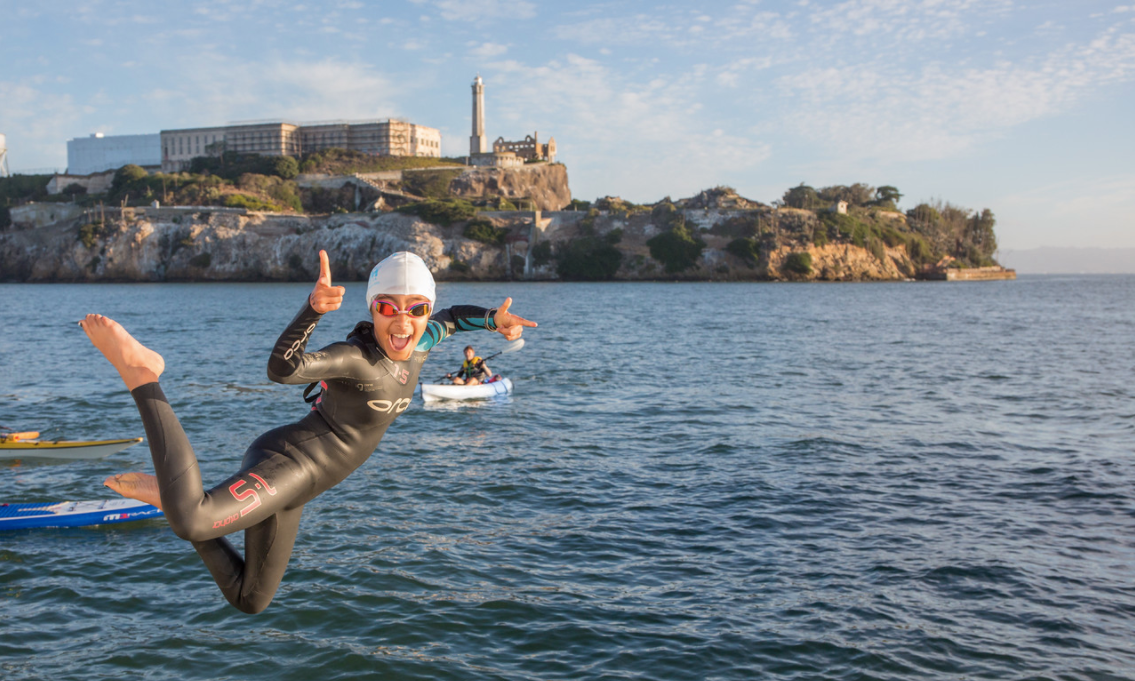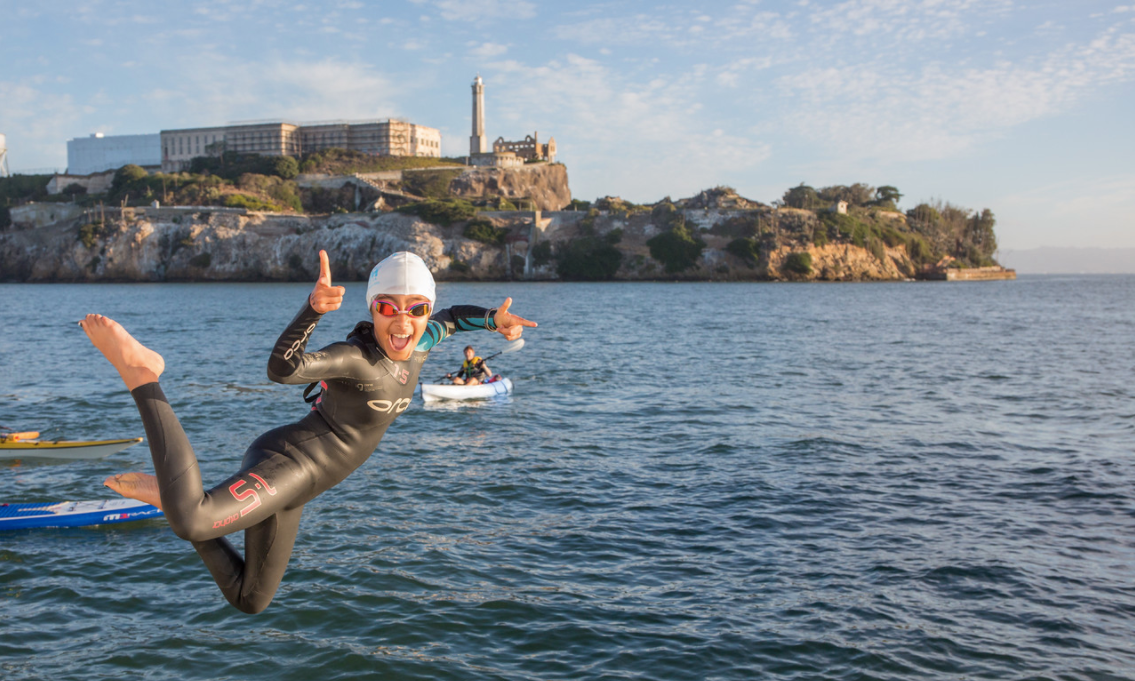
The waters between North Beach and Alcatraz are not shark infested, as urban legends would have you believe. Most sharks can’t live in the bay’s fresh water, as their fatty livers aren’t functionally flotational without salination. Take the Journal of Experimental Biology’s word for it: sharks don’t have the “fancy air bladders” of modern fish. Once they cross the threshold between ocean and bay, they begin to sink, faraway from the habitable waters of their ilk and farther away from the delicious limbs of swimmers.
Mitali Khanzodé, who, at age 15, has made the Alcatraz swim 33 times, is quick to explain this common misconception to me. “The real threat is hypothermia,” she says. She also tells me, “Wetsuits chafe horribly.” The tradeoff between chaffing and dying of hypothermia seems small when the average temperature of the water is 60 degrees and you “feel so cold your limbs start to go numb.” As Mitali explains, “Sometimes it’s difficult to tell your hands are turning white.” Despite this, she is already swimming races in “skin” — without a wetsuit — in order to prepare herself for more advanced races that require it.
In a normal race, being rescued or relocated by a kayak doesn’t disqualify you — if anything, the time lost is the penalty — but a world record is no longer in the cards the moment you accept assistance.
Mitali and her little sister, Anaya, are two of the youngest swimmers to have successfully swum to Alcatraz, making their first passages at age ten and eight, respectively. Nailing a world record is no cakewalk, and Anaya became the record holder at age ten. In a normal race, being rescued or relocated by a kayak doesn’t disqualify you — if anything, the time lost is the penalty — but setting a world record comes with stricter qualifications. This means physical contact with anyone who isn’t a participant — even something as innocuous as accidentally touching the hand that offers a water bottle — is disqualifying. This is why food is thrown at marathon swimmers in little plastic baggies, like feeding a fish.
I have difficulty separating the prison mythos of Alcatraz from “prestigious open-water swimming locale.” I’m watching hordes of swimmers pile onto a ferry, pulling over the waves to the starting mark of the race. They’re about to start Swim around the Rock — a race that is exactly what it sounds like. As their bodies hit the water, I conjure wistful images of prisoners forced to stare at the San Francisco skyline, separated by a thin sliver of water. The bay is its own formidable force of containment. Sharkfest, one of the largest Alcatraz swim competitions, warns that the race is “not for novices” and requires participants to be able to swim a mile in under 40 minutes. Another competition host, Water World Swim, limits their races to 30–35 swimmers as a safety precaution.
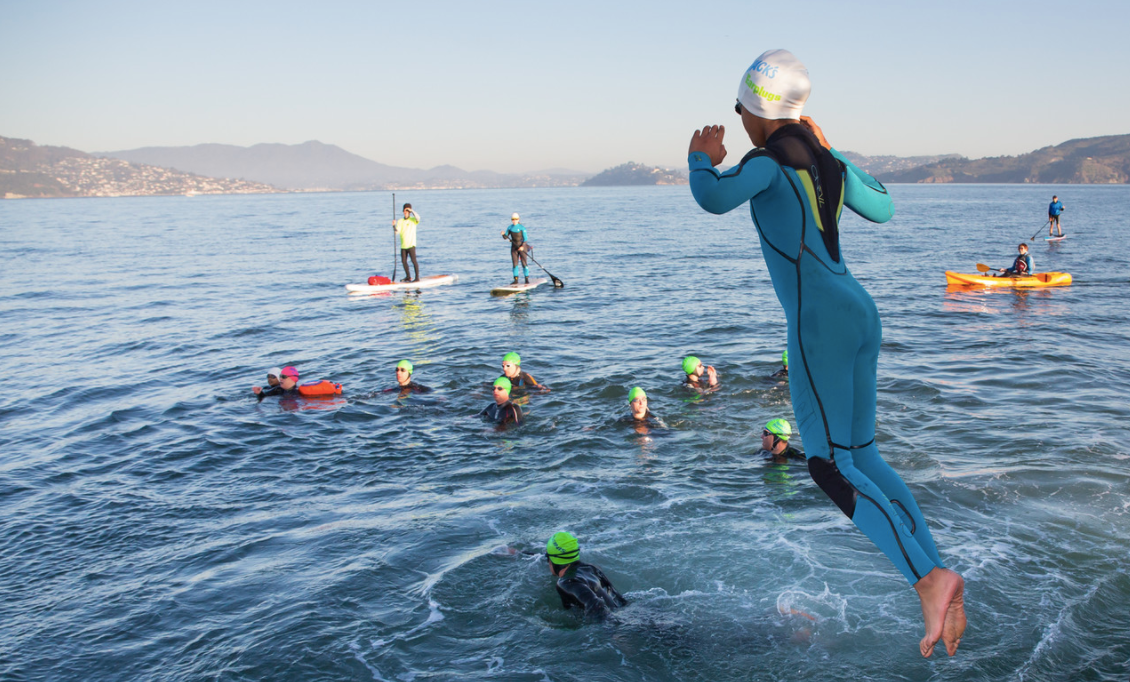
Races are organized with safety in mind. Participants train in open water for months before races to acclimate to the ferocity of elements like wind, temperature and current. The US Coast Guard will cancel the race if conditions are too volatile, and the course is chaperoned by kayakers who aid swimmers who are going too far off course or require relief from exhaustion or injury. But this isn’t always comforting, Mitali explains: “It can be so hard to hear a kayaker trying to help you that they have to smack you in the head with an oar to get your attention.”
Open water has never been my friend. Dipping a toe into the ocean feels like a preamble to drowning. When I watch a friend dart into the water, I keep my eyes glued to them, experiencing mild bouts of panic every time they don’t surface regularly like a buoy. But I am still mesmerized by the ocean. When I feel courageous, I walk until the water laps at my shins, and I feel like I’m in the middle of an infinite well.
The question “What does this swim even feel like?” assails me with a dogged persistence. But trying to coax either of the sisters to elaborate yields only a vigorous refrain of the phrase “mental fortitude.” “At some point in the race, you will want to give up,” Anaya tells me. “You’ll probably hate yourself for even starting the swim.” This isn’t making me want to swim. “That’s why you have to keep telling yourself that you can do it. And sometimes it’s as easy as singing to yourself to stay on rhythm.” The song? The “Just Keep Swimming” ditty sung by Dory (the royal blue tang voiced by Ellen DeGeneres) in Finding Nemo. James Savage, the most recent world record holder, swims to the same mental tune. Ellen DeGeneres has inspired this generation of open-water swimmers.
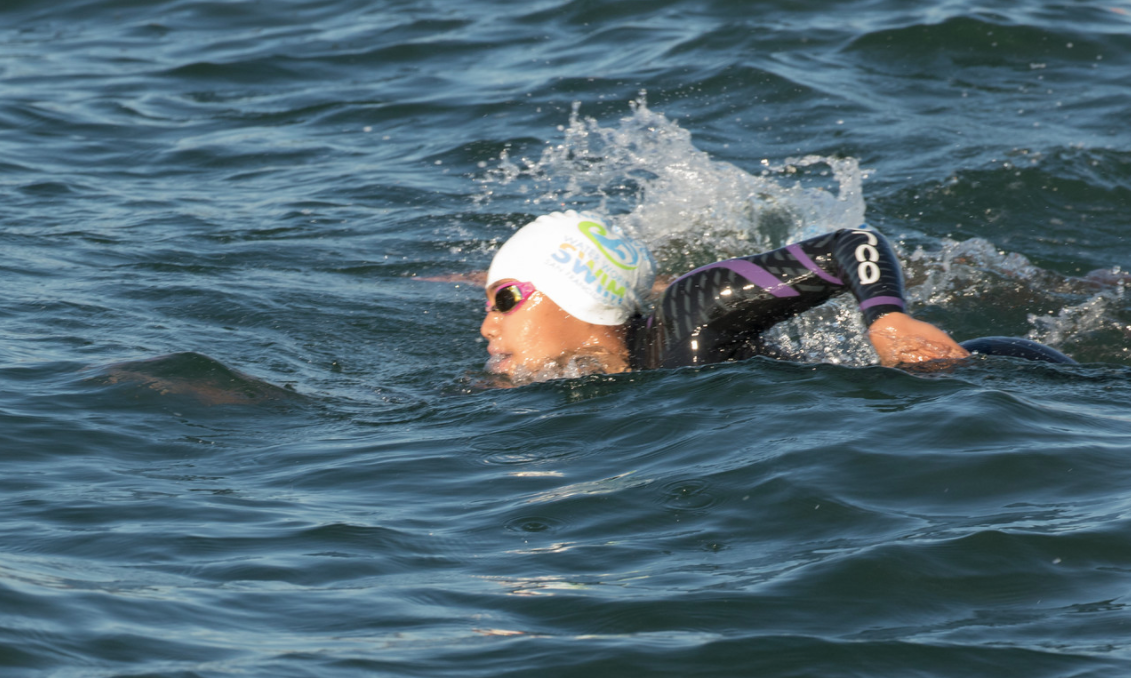
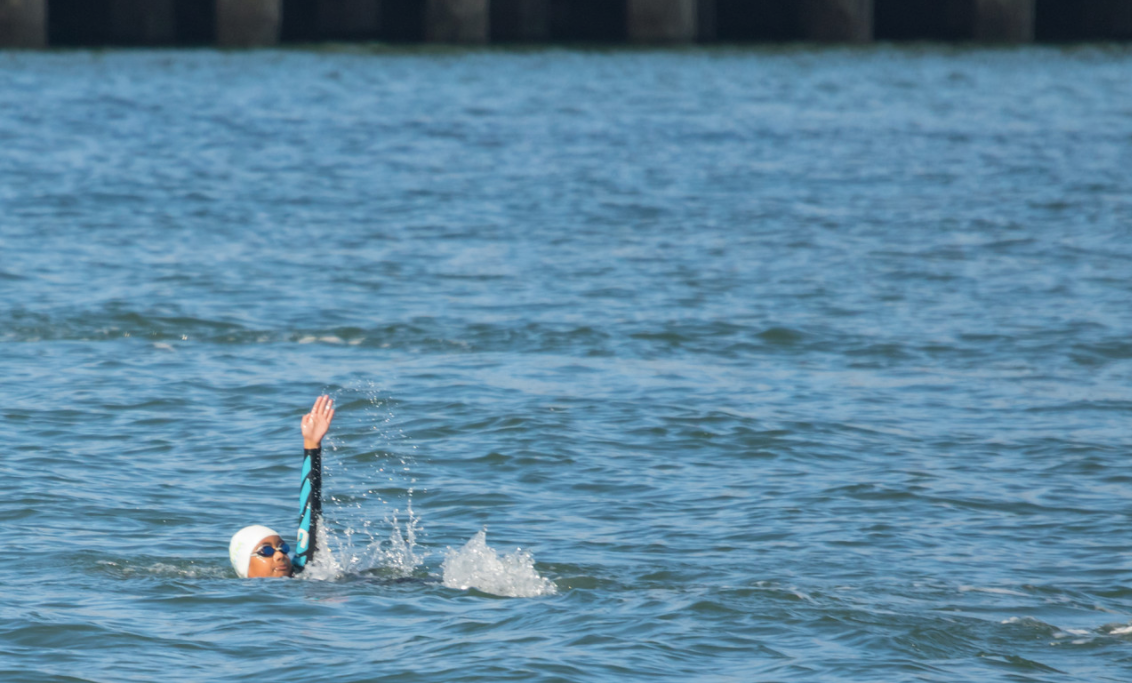
Rather than elaborate on the tactile experience of open-water distance swimming, Mitali describes her strategy in intricate detail. As she explains, “The hardest part of swimming to Alcatraz, and the part I’m the worst at, is sighting.” Sighting is tidal course correction. Before the race, the US Coast Guard will report on ebb and flow, informing swimmers of the direction in which they’ll need to swim in order to cancel out the tide’s combative forces while catching pockets of helpful currents. When Mitali explains what it’s like to miss these currents, I imagine a pinball hitting slightly left of center and being launched belligerently into the pit between the flippers. Which isn’t to say that sighting incorrectly will kill you. It just means that it would suck.
There is something undeniably Silicon Valley–esque about their work ethic. They tackle swimming challenges with a shockingly adult level of levelheadedness. I don’t mean to fetishize them as characters rather than individuals; both girls are possessive of vibrant personality. Mitali waxes poetic about writing poetry, and Anaya gabs about how special it is to be “swimming with [her] sister.” They’re so enamored of their sport that their various wins are clearly secondary. But both are still acutely aware of how decorated they are and how much work it took to get there.
If Anaya and Mitali epitomize the superhuman Silicon Valley–child prototype, James Savage is the embodiment of an athletic prodigy. In 2016, less than a year after Anaya set the record at age ten, James broke it at age nine. At first glance, he appears unremarkable. This isn’t an insult — I simply mean he isn’t a novelty. Yet he’s got the brute force and unbridled energy that can exist only in young boys. The charm of James Savage is his validation of a deeply held American belief: dreaming wildly sometimes pays off.
The charm of James Savage is his validation of a deeply held American belief: dreaming wildly sometimes pays off.
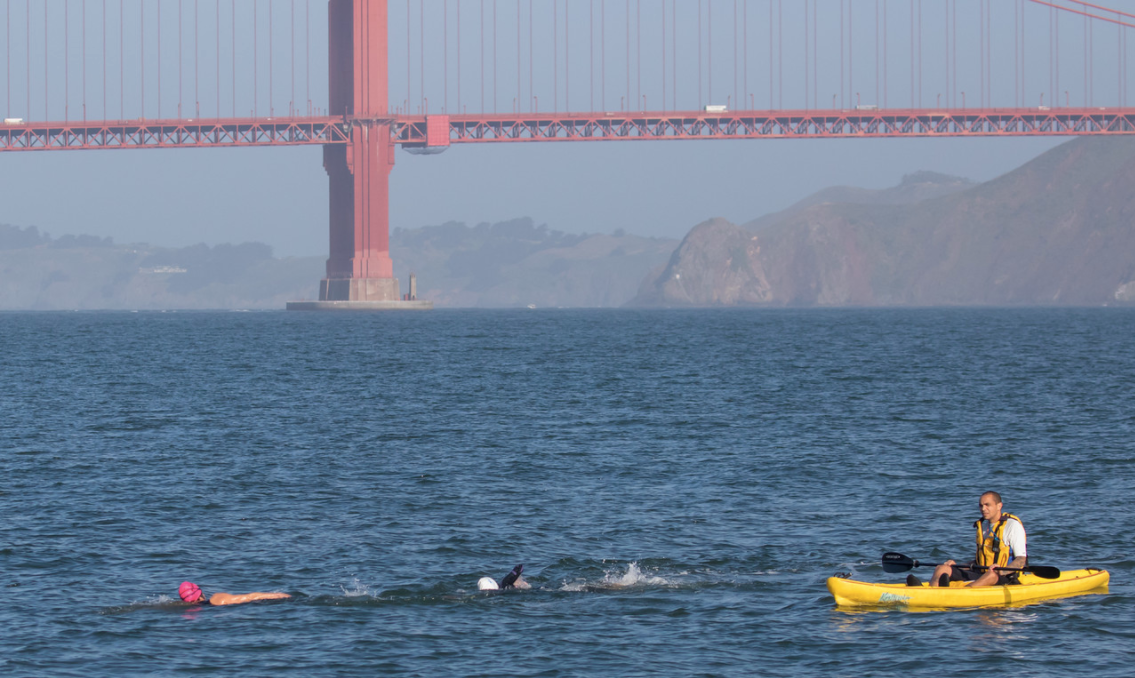
James can barely make eye contact. He fidgets compulsively, gnawing at his sleeves before dragging them across the glass table, while letting his body slide repeatedly off the sofa and onto the ground. For 80 percent of our conversation, he looks like the clock from Dalí’s The Persistence of Memory. I imagine dozens of articulate interviewers peppering James with questions, attempting to find mellifluous quotes that articulate precisely what makes him light up. But James Savage is shy, and talking to a shy kid means getting repeatedly stonewalled.
I ask him, “What do you do when you get tired?” and he responds, “I keep swimming.”
I ask him, “What do you do when there’s a wave coming?” and he responds, “I swim over the wave.”
I ask him, “Why do you want to do independent study? “and he responds, “so I have more time to swim.”

But James transforms into an encyclopedia when I ask him for specific advice. His coaches have taught him to “turn more clean [sic] so that [he can] move faster. And to not worry about breathing too much.” I hadn’t even thought about breathing. Actively putting effort into “good” breathing on top of all these physical machinations feels like parlaying with the devil himself. Are you sighting correctly? Are you even going to correct direction? If this feels like a lot, that’s because it is. A number of swimmers clam up on the ferry and never jump into the water. Apparently, around the three-fourth’s mark of most races, kayakers are on hyper-alert because swimmers begin to experience severe fatigue and shoot out in a number of incorrect directions. They have to be fetched (by kayak, usually) and put back on course.
It’s this rigor that has competitors threatening to call Child Protective Services on James’s parents. It doesn’t help that James’s decision to swim to Alcatraz appears to be without forethought. His rationale for swimming his first open-water race was that he “just wanted to.” His parents passively agreed, in the way a mom might validate a child’s dream of being the next Michael Jordan. But James was not lying. A few months later, Jill Savage learned to kayak so that she could accompany him during every race. His parents are the furthest from neglectful. Spending five minutes with the boy makes it agonizingly obvious: he just really fucking wants to swim.
James’s wide-eyed ambitions are not that unusual for a child — what nine-year-old is a paradigm of logic? — but unusual in that he has been so successful. Rather than being fearful of imminent threats like hypothermia, James’s biggest concern in his first race was “not putting [his] face where there might be shark poop.” He swam his first race without putting his head in and persisted to swim in this manner until his coaches persuaded (lied to) him about a series of nets that “would filter out the poop.” James once swam an entire meet after breaking his foot on the starting block. When I ask him why, without batting a lash, he responds, “I’m not a quitter.” Everyone tried to get him out of the pool, but he wholesale refused. He finished the swim meet limping and decorated in medals. Instead of medical treatment, James asked for ice cream. His parents did not oblige.
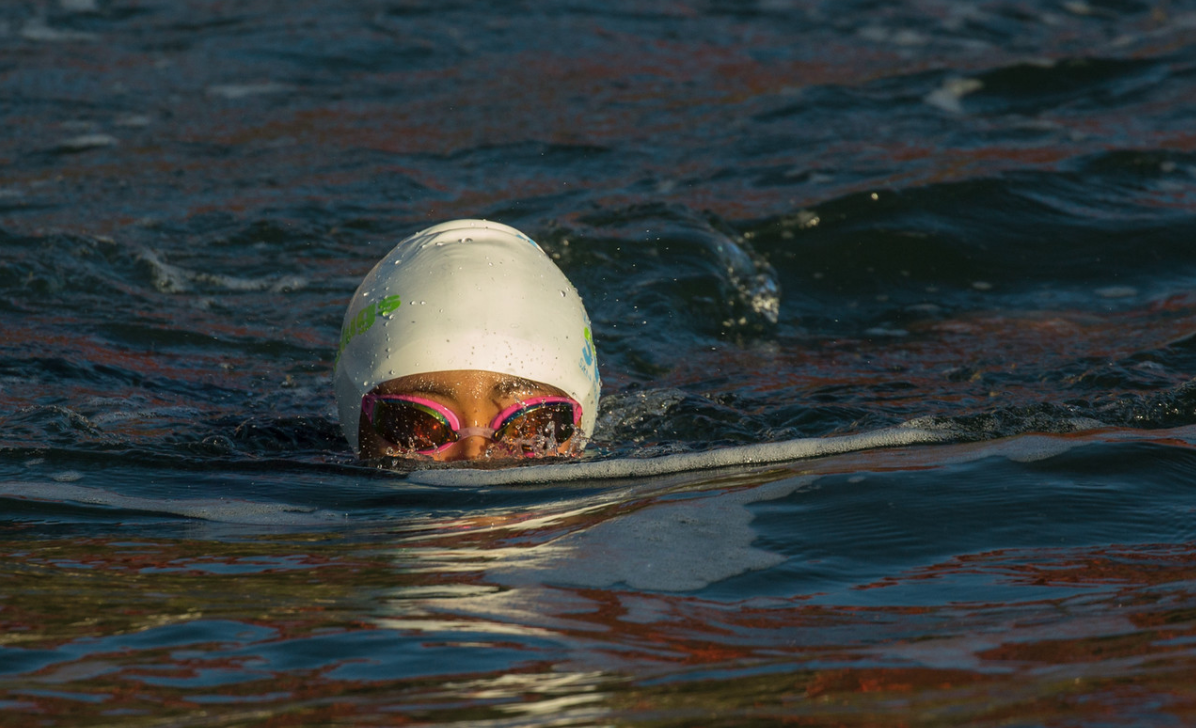
It’s this irresistible drive that ties Mitali, Anaya and James together, despite their irreconcilably different backgrounds. Their dedication and command of the open water has made them personal friends with Olympic distance swimmer Keri-Anne Payne. James goes from school to swim practice, and then to ESPN interviews and a prerace dinner with other Olympians — all while wearing shark-footie pajamas. We all know what it means to love something this much, but not many of us can fathom it happening so early and with such great success. It’s especially jarring for those, like me, who can’t fathom getting into the water at all.
To those who are hoping that their kids can pursue the sport: put them in swimming lessons now, and pray feverishly that they’re natural-born masochists. There’s no way you’ll convince them to swim the three-mile stretch unless they want to do it themselves. I intend to stay as far ashore as possible.



